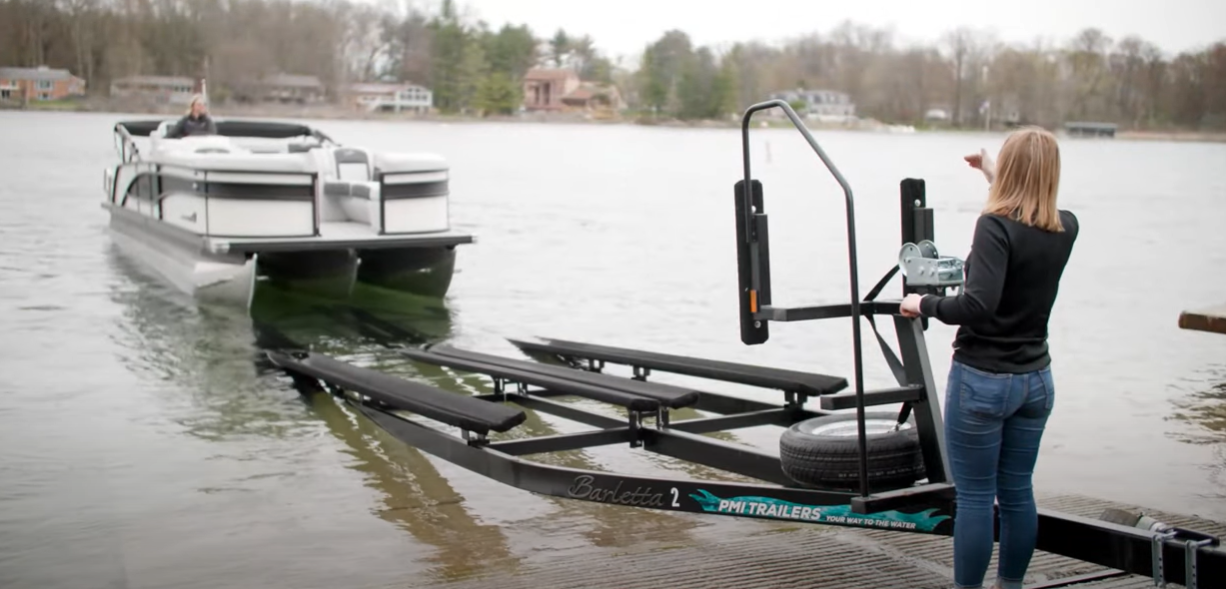How to Pull a Pontoon Boat Out of the Water (4 Easy Steps)
No one ever wants to think of the boating season coming to an end. Growing up on a lake in northern Indiana, I always knew the fun was coming to an end even before there was a chill in the air.
All the trees that bordered the water seemed to turn just a smidge darker green and there was a gentle breeze that would make the leaves flutter in such a way that signaled fall was around the corner.
As a kid, this also meant summer break was coming to a close so naturally I grew to dread this turn of events. Not only were all of my laker friends getting ready to pack up and head home, but my favorite pastime was also nearing the end.
Days on the water were numbered and soon, I would be helping my family plan out our winterization process. When I was old enough and had my boater’s license, I would often help pull our pontoon boat out of the water.
After years of prepping our boat for winter, I put together this quick guide to pulling a pontoon boat out of the water. Using these four easy steps, you should have your boat out in no time and stored away for the winter months.
How to Pull a Pontoon Boat Out of the Water (Step by Step)
1. Prepare the Boat
Before I leave the dock to head to the boat ramp, I make sure I’ve cleared everything off that I plan on storing in the garage over the winter. This can include anchors, extra towels, sunscreen, or anything that doesn’t need to sit in the boat while it’s in storage.
I also like to make sure all wet items such as used lifejackets are taken off and the storage compartments are completely dry. Letting a wet boat sit in storage can lead to mold and mildew wherever that moisture lands.
Make sure you’re ready to take the next steps of the winterization process that are necessary once the pontoon boat is on the trailer. Some like to power wash the toons, others plan to vacuum the entire boat.
Some people, like myself nowadays, take it straight to their dealership so that they can take care of winterizing the boat. Whatever your plans are, make sure you’re prepared for the next steps before you leave the pier.
You should also take the weather into consideration before heading to the boat ramp. Lining a pontoon boat up on a trailer is much more difficult if there are high winds and strong currents. If you’re experiencing bad weather, maybe wait until tomorrow to pull the boat.
If you’ve got good weather and the boat is ready to be tucked away for the winter, head over to the boat launch. This is where the buddy system comes into play.
2. Buddy System
Just like launching a pontoon boat, the process of pulling it out of the water is made easier when two people are doing it. Find someone who knows how to tow a boat trailer and have them meet you at the launch. It’s also critical to confirm that their tow vehicle is capable of towing the weight of your trailer with the boat on it.
I like to time it out so that my tow vehicle driver isn’t waiting too long at the ramp for me to get there by boat. If you’re lucky, you’ll arrive around the same time. Make sure to assess the launch and don’t crowd the area if there’s a long line of vehicles waiting to pull out their boat.
The last thing you want to do is get in the way of someone else while they’re pulling or launching their boat. An inexperienced boat driver can turn this situation dangerous in an instant.
3. Pull the Boat Out of the Water
Once you and your buddy in the tow vehicle are both at the launch, wait for them to back the trailer down the ramp. Next, it’s time to line the toons up with the bunks. This will vary depending on the type of pontoon trailer you have.
For instance, if you’ve got a bunk-style trailer, lining the toons up may take a little more effort as the bunks are harder to see. You can add bunk guides to this type of trailer that stick out of the water and help guide the toons into place.
I recommend bunk guides especially if you’re not an experienced boater. They make the process of lining up the toons just right in the bunks much easier. Another tip to make this process easier is to only back the trailer down about half way into the water.
This will allow the front of the bunks to be visible and give the boat driver a better view of where the toons need to go. Once the toons are lined up, slowly put power into the throttle until the boat is on the trailer.
Now the driver of the tow vehicle can back into the water further in order to let the boat glide the rest of the way on. Once you hit a certain point on the trailer where the toons are mostly out of the water, you may need to give the throttle a gentle nudge to get the boat all the way up on the bunks.
Lineup the Stern
Next, check and make sure the stern of the boat is lined up in the bunks. You may need the driver to pull forward on the ramp slowly until the back of the trailer is starting to emerge. This way, you will be able to see if the back of the toons is nestled in the bunks. If you do it this way, make sure the engine is turned off.
If they are not, then the driver will need to slowly back down the ramp once more and you can either float the boat to the side of the bunks in which they need to shift. You can also turn the engine back on and slowly reverse in the direction that the bunks need to go.
Once the toons are aligned in the bunks and the boat is all the way up on the trailer, the driver of the vehicle should put the truck in park and hook the trailer strap onto the front of the boat. This strap will secure the front of the boat from bobbing while it’s being towed down the road.
While the driver of the tow vehicle goes through the above steps, you should take this time to secure the interior of boat. Make sure the bimini is lowered to the trailering position. You should also put away anything that could fly out of the boat such as the mooring cover or dock lines.
Take this time to turn off the battery switch and power down the boat. This way you don’t have anything that’s potentially left on killing the battery. Lastly, make sure you’ve trimmed the motor up so that it doesn’t scrape the pavement once it’s pulled up on land.
4. Time to Tow
Now that the pontoon boat is secure on the trailer, the driver of the tow vehicle should pull up and out of the ramp and clear the way for others who are waiting to use the launch. There’s nothing worse than a driver who hangs around too long blocking the ramp.
Once you’re pulled up and out of the way, stop and let the boat driver off of the boat. They may need assistance getting down the boat ladder or the trailer ladder as it’s a far distance from the ground.
Do one more assessment of the trailer now that the boat is on just to make sure everything looks right. If the toons are not fully on the trailer or the boat is too far back, you will need to back down into the water and reposition the boat.
It can become dangerous if you’re towing a boat down the road that’s not sitting on the trailer properly. If you’re using a scissor-style trailer, you’ll want to make sure the boat is in a good position as it will experience more side-to-side movement than you would see with a bunk trailer.
Stowed Away
With the pontoon boat out of the water, sitting on the trailer now is the time to prep the boat before it goes into storage. Whether you plan on winterizing the boat yourself or taking it to your dealership to have them do it, this is the perfect time to shore up any last details.
Go through the boat and take out any other items you want to store separately. If you’re planning on cleaning the exterior there are a few places you can do this. Some people take their boats to the self-service car wash bays. Others take it home and do it in their driveway.
Either way, cleaning down the toons is easiest when it’s out of the water. Some also like to deep clean the interior before it goes into storage each year. Doing may deter critters since many times, there are crumbs left behind from sandbar snacks.
Putting the boat away in storage may be every boater’s least favorite day of the year. I just think it’s the day the countdown starts again for next season. While the boat is in storage, this is the time to reflect on what you may need to make next season great.
Maybe it’s worth finding the dates for your local boat show in the months to come. If you’re contemplating an upgrade, now is the time to discuss your options with a dealer. From a manufacturer’s standpoint, you can never order a boat soon enough to ensure that you’ll take delivery by the following summer.



